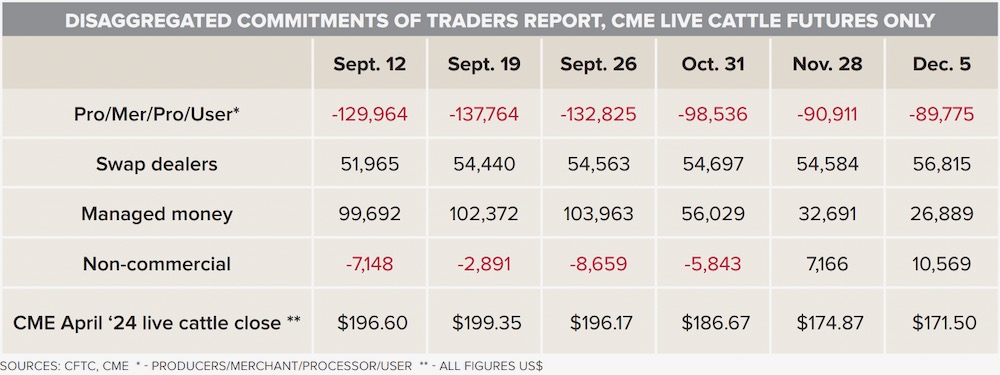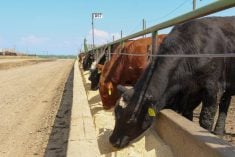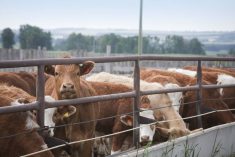Who is long? Who is short? How much of each? This is the most important market information when studying the futures markets.
The Commitments of Traders (CoT) report is released every Friday afternoon by the U.S. Commodity Futures Trading Commission (CFTC) and shows the trading positions of market participants as of Tuesday’s close. Whether you are a cow-calf producer in Saskatchewan or a meat packer in the U.S., all participants in the market need to pay close attention to the Commitments of Traders report.
Read Also

Gentle treatments for pain in the neck
Heading toward year-end, people unknowingly tense up against the cold and busyness, causing neck pain that can often be treated with appropriate support and gentle mobility, athletic therapist Kathlyn Hossack says.
For example, fed cattle fundamentals can be extremely bearish, but a market will not go down if the commercial end-user or packer has no coverage in the cash market. On the flipside, fed cattle fundamentals can be extremely bullish and supplies historically tight; however, the market will not go up if packers have their needs covered for the next two months.
The Commitments of Traders report can help cow-calf producers and backgrounding operators on the timing of purchasing price insurance. It can also help finishing operations on the timing of booking forward contracts with the packer.
I’ve received many inquiries about this report throughout the fall period as the live and feeder cattle futures were trending lower. I’ve discussed this information in the past but it’s prudent that cattle producers understand this report for marketing cattle in 2024.
In this article, I will focus on the Disaggregated Commitment of Traders report. This report splits commercial traders into two categories. The first category is producers, merchants, processors and users. The second commercial category is the swap dealer. Non-commercial traders are also split into two categories: the first is the managed money, and the second is the other reportables.
The commercial category of producer/merchant/processor/user is often referred to as “the packer.” These are direct hedgers. The position in the cash market is the direct opposite of their futures position. The commercial trader transfers the price risk of their cash position to the speculative trader.
Therefore, when the commercial trader is buying and the managed money is selling, this is bearish for the market, or characterizes a downward-trending market. When the commercial trader is selling and the managed money is buying, this characterizes a bullish or upward-trending market.

Above we see the net positions of each trader group on Sept. 12, 19 and 26, 2023. This is exactly when live cattle futures started to turn lower. From Sept. 12 to Sept. 19, the commercial trader was an active seller while the managed money was a net buyer. This characterizes an upward trending market.
Notice the Sept. 19 close is higher than the Sept. 12 close, and this was when the April live cattle futures made contract highs. When the commercial short position is near 140,000 contracts, it’s similar to a grain elevator, with 200,000 tonnes of capacity, filled to 199,500 tonnes.
“The water jug is full.” That is, even though supplies are tight, the market will not go up because demand is full. The end user is covered. There is no demand.
From Sept. 19 to Sept. 26, the commercial was a net buyer of nearly 5,500 contracts and the managed money was also a net of nearly 1,700 contracts. The commercial buying was a signal not to be long live cattle futures and start forward contracting. By Oct. 31, the commercial short position had increased to a short of 98,000 contracts while the managed money long position had decreased by 48,000 contracts.
Commercial buying and managed-money selling characterizes a downward-trending market. The commercial short position continued to increase, and the managed money continued to decrease, through November. Notice the lower live cattle futures close on each day.
Moving into December, the commercial short position increased above 90,000 contracts. The elevator is empty. The packer needs coverage. The market made a low of US$165.40 on Dec. 6 before starting to trade higher.
Carcass weights have been increasing and there is a backlog of market-ready fed cattle supplies in the U.S. However, the fed cattle market will not go lower because the U.S. packer has significant open demand.
To make an analogy, the elevator is relatively empty, or only holding about 5,000 tonnes, with an upcoming vessel to fill of 20,000 tonnes. On Jan. 9, 2024, the commercial short position was only 73,000 contracts. The live cattle futures will not go down in this environment. At the time of writing this article, on Jan. 16, April live cattle futures were just above US$175, their highest since Nov. 28.
It’s important that cattle producers have a good idea of the futures position of each group of participants in the market. When the commercial and managed-money positions are at an extreme low or high, this is a turning signal for the market.
We could also show the same type of activity for the feeder cattle futures. This can be a very helpful tool to determine when to buy price insurance on calves or backgrounded cattle.
Supplies can be tight but that doesn’t guarantee the market will go up if the packer has significant coverage in the cash market. When demand is full, the market goes down regardless of the fundamental situation.
















